Yoga Asanas For PCOS | Polycystic Ovary Syndrome:
Jump To:
PCOS is one of the most common causes of female infertility, affecting 6% to 12% (as many as 5 million) of US women of reproductive age. Polycystic ovary syndrome (PCOS) is a health problem that affects 1 in 10 women of childbearing age. PCOS is a lifelong health condition that continues far beyond the child-bearing years. But it’s a lot more than that. Yoga for PCOS along with a healthy lifestyle helps you balance your body’s hormones and their functioning.
Lifestyle changes in a combination of proper diet management (Diet for PCOS), exercise, and a stress-free lifestyle are effective to control PCOS. Also, Nadi Shodhana Pranayama and Yoga Inversions are also beneficial to clean the body. Check out Yoga Inversions Benefits for more details. Don’t forget to relax in Yoga Nidra with savasana and avail the complete benefits of the asanas practiced. You can practice yoga nidra for regular good sleep which is important when you have PCOS.
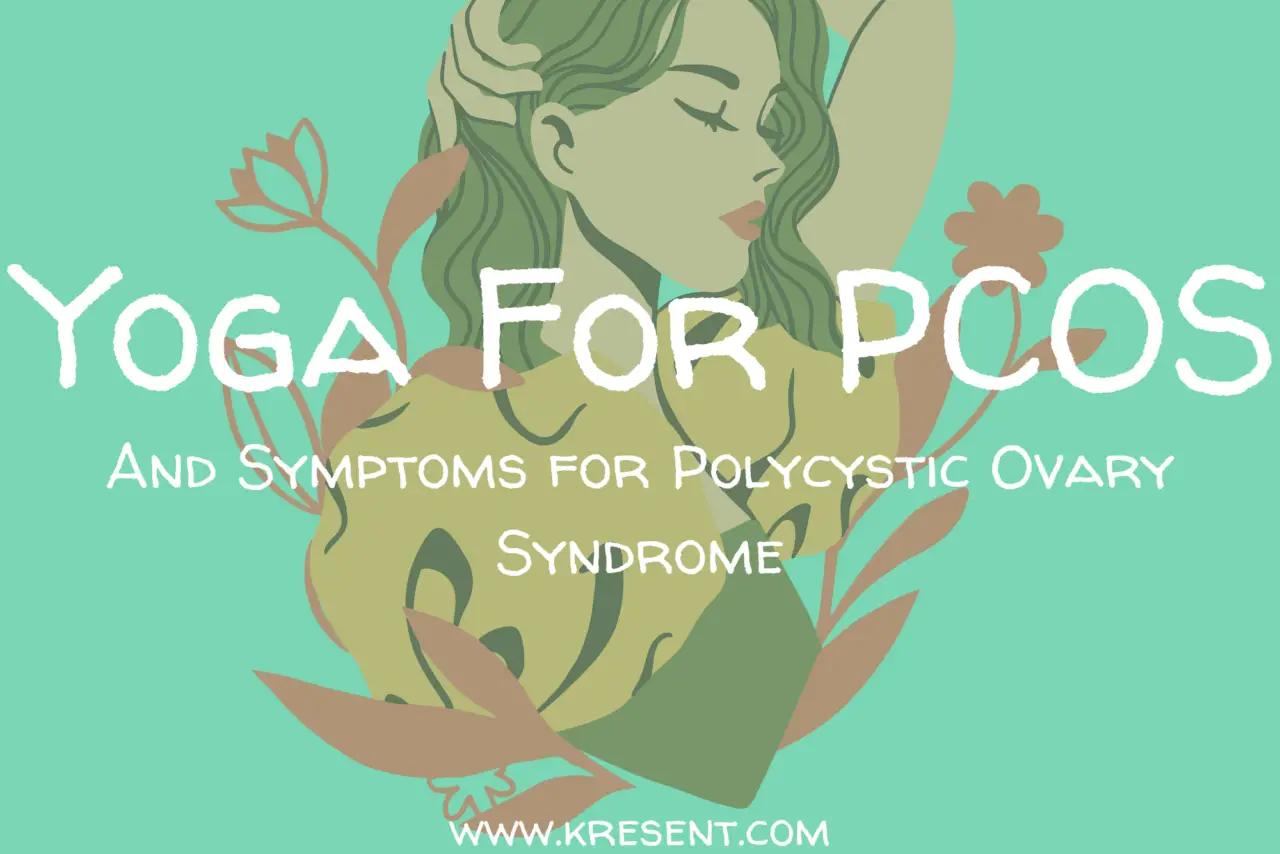
Polycystic Ovary Syndrome – PCOS Symptoms:
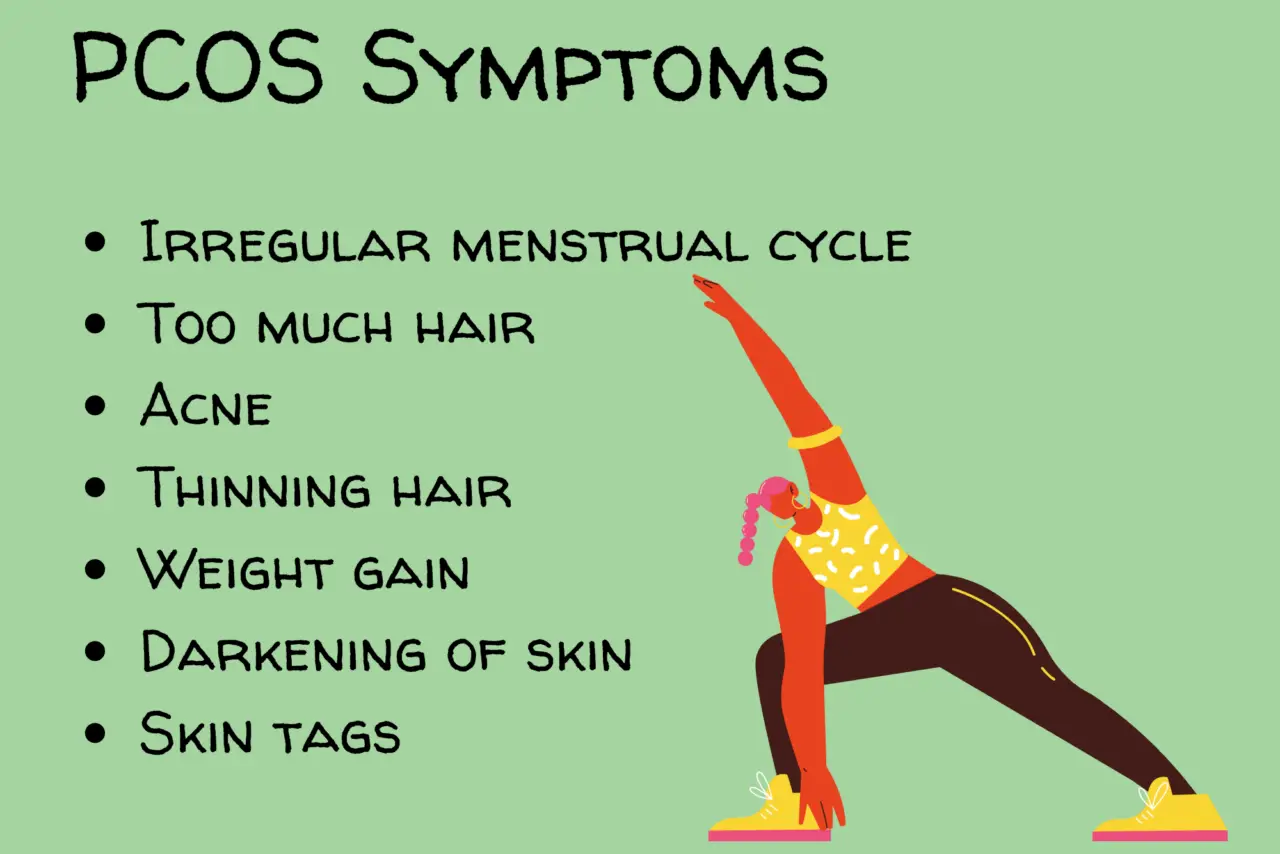
- Irregular menstrual cycle. Women with PCOS may miss periods or have fewer periods (fewer than eight in a year). Or, their periods may come every 21 days or more often. Some women with PCOS stop having menstrual periods.
- Too much hair on the face, chin, or parts of the body where men usually have hair. This is called “hirsutism.” Hirsutism affects up to 70% of women with PCOS.
- Acne on the face, chest, and upper back
- Thinning hair or hair loss on the scalp; male-pattern baldness
- Weight gain or difficulty losing weight
- Darkening of skin, particularly along neck creases, in the groin, and underneath breasts
- Skin tags, which are small excess flaps of skin in the armpits or neck area.
Can Yoga Cure PCOS:
Women with PCOS have hormonal imbalances and metabolism problems that may affect their overall health and appearance. Yoga can cure the cause of PCOS as hormone imbalances are mainly caused based on the way we handle ourselves.
Though PCOS is also a common and treatable cause of infertility, yoga for PCOS is the way to balance your hormones gradually and maintain good health condition.
Yoga For PCOS | Yoga For Ovarian Cysts:
This yoga for PCOS helps to strengthen the organs and body systems affected by PCOS and also reduces the stress that can aggravate the condition.
Also, studies found that yoga for PCOS was significantly better than regular exercise in reducing anxiety symptoms in adolescent girls with PCOS.
1. Setu Bandhasana (Bridge Pose):
This pose relieves the tension and stress in the back muscles instantly. It calms the brain, reducing anxiety, stress, and depression.
Setu Bandhasana Steps:

- Lie on your back, fold your knees and place your feet hip distance apart on the floor and away from the pelvis.
- Place your palms facing downward beside your body.
- Inhale; slowly lift your lower back, middle back and upper back off the floor gently roll in the shoulders; touch the chest to the chin without bringing the chin down, supporting your weight with your shoulders, arms and feet. Feel your bottom firm up in this pose. Both the thighs are parallel to each other and to the floor.
- Keep breathing easily.
- Stay in this pose for 1-2 minutes.
Release the pose exhaling and lower the hips, lower back and upper back on to the floor gently.
2. Malasana (The Sumo Pose):
This yoga for pcos can truly change the way you use your body as squatting has a deep positive impact on mobility and balance.
Malasana stretches several lower-body major muscle groups. Strengthens and makes ankles flexible, increases mobility in the hips, stretches the back and soothes back pain.
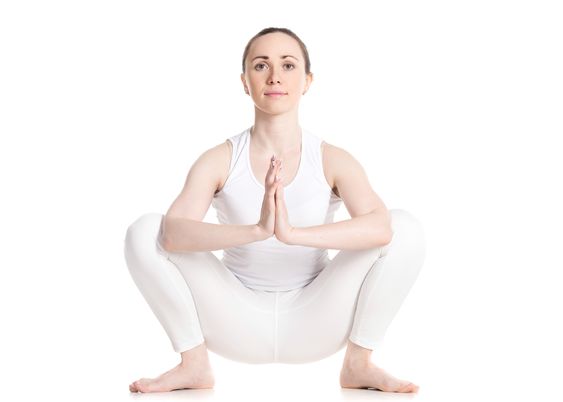
Malasana Steps:
- Squat as deep as you can.
- Push your knees out with your elbows, hold a namaste near your chest, breathe.
3. Bharadvajasana:
Massages the digestive and reproductive organs. This pose also helps to loosen the muscles around the spine, lower blood pressure, and soothe the nervous system.
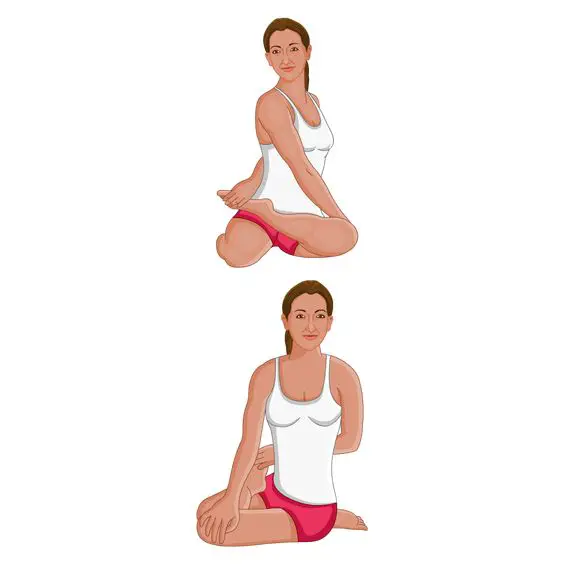
Bharadvajasana Steps:
- Sit on the floor with your knees bent and your feet on the floor. Place your hands behind you and sit up tall.
- Slowly let your knees fall to the left so that the right thigh is on top of the left foot.
- Place your right hand on the floor behind you and take an inhale to reach your left hand up.
- Exhale, to twist to the right, placing your left hand outside of your right thigh. Hold for 8 breaths, then switch sides.
4. Baddha Konasana (Bound Angle Pose):
This is a classic pose in the asana practice as it benefits the entire body. Apart from being an excellent hip opener, it stimulates the abdominal organs, the ovaries, kidneys. It stimulates the heart and improves circulation.

Baddha Konasana (Bound Angle Pose) Steps:
- Sit with your legs straight in front of you. Lift the hips a bit off the floor and place a cushion under.
- Inhale; bend the legs towards the chest. Exhale; drop the right knee to the right and the left knee to the left and allow the souls to touch each other. Place the palms on the floor behind the hips and extend the spine by pressing on the palms.
- Hold this pose, breathing deeply for 10 breaths.
- Inhale; lift the palms and reach forward to hold the toes or the feet with both your hands.
- Exhale; bend the elbows on to the thighs and press them down towards the floor, feeling a stretch on the hips and the thighs. If the knees don’t touch the floor, do not force them as this is due to tight hips. Place a block or bolster under the knees to support them.
- Hold this pose for a few breaths; release.
5. Marjariasana (Cat stretch):
This yoga for PCOS pose relaxes the mind and improves blood circulation.
Marjariasana Steps:

- Stand on your four limbs like a table with palms placed shoulder-width apart and toes placed hip-width apart parallelly. Look straight ahead.
- Inhale; raise your chin and tilt your head back, push your navel downwards and raise your tailbone. Compress your buttocks and feel a slight tingle. Take deep breaths.
- Exhale; drop your chin to your chest and arch your back up as much as you can and relax the buttocks. Take deep breaths.
- Then come back to the table position. Do 2 and 3 alternately for a few minutes.
6. Naukasana (Boat Pose):
This yoga for PCOS asana is slightly difficult to perform but is highly beneficial in exercising the pelvic region.
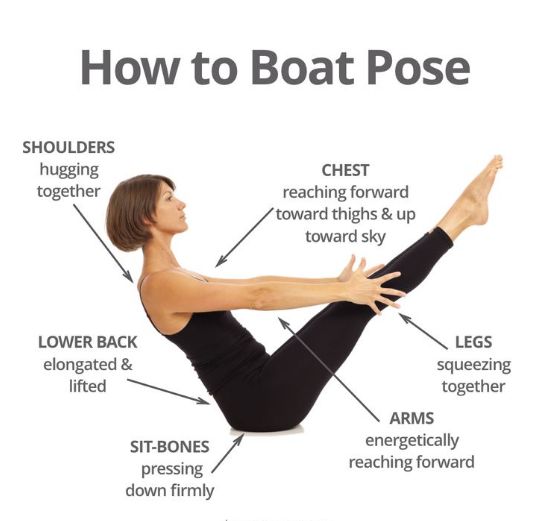
Naukasana Steps:
- In this yoga asana, you lay down on your back.
- Place your hands stretched in front and join the palms. Stretch your feet outside.
- Inhale; slowly raise your legs and the upper part of your body while keeping the pelvis on the ground.
- Hold this position for a few seconds and get back to your earlier position by slowly exhaling.
7. Prasarita:
Prasarita Padottanasana in Sanskrit, is vital to stretch the hamstrings, groins, hips and lower back. This pose allows the entire back of the legs to open.
Prasarita increases blood circulation to the ovaries while relieving tension in the hips and lower back.
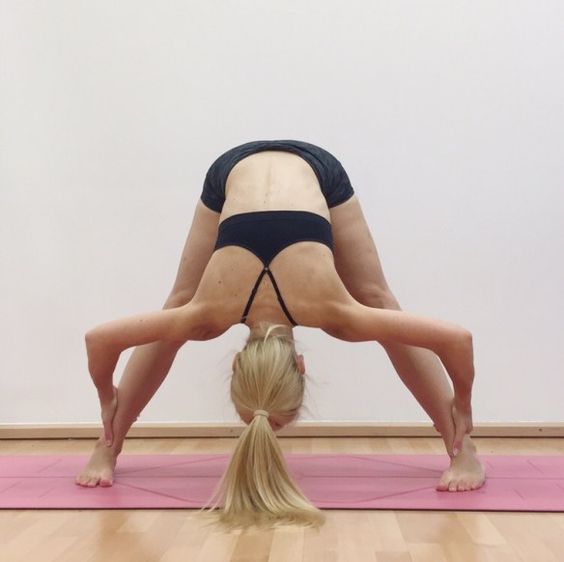
Prasarita Steps:
- Start standing with your feet out wide. Point both feet forward so that they are parallel to one another.
- Bring a small bend into your knees and slowly fold forward with a flat back.
- Place your hands on the mat. Let your head and shoulders hang heavy and shift your weight towards the balls of your feet. Feel your spine lengthen. Hold for 8 breaths.
8. Bhujangasana (Cobra Pose):
This is great for the upper body and lower-spine strength and flexibility. Regular practice of Bhujangasana, improves blood circulation around the spinal vertebrae.
It stretches muscles in the shoulders, chest and abdominal region. Bhujangasana decreases stiffness of the lower back, strengthens the arms and shoulders, increases flexibility, elevates mood, firms and tones the gluteal muscles, and relieves stress and fatigue. It also opens the chest and helps clear the passages of the heart and lungs and strengthens the spine.
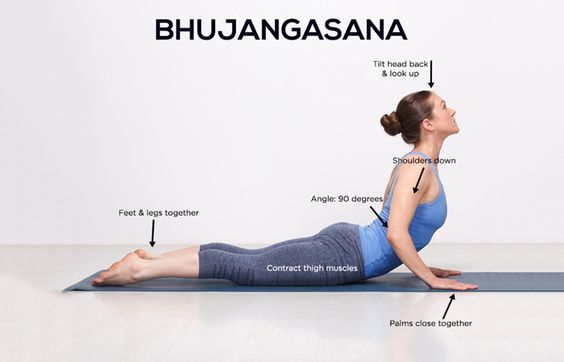
Bhujangasana Steps:
- Lie down on your belly with legs hip distance apart.
- Place your palms a little ahead of your shoulders with elbows on the floor.
- Inhale; internally rotating the thighs in, press the legs down on the floor. See that the toes pressing down with ankles are lifted up.
- Tuck the tailbone down by drawing the pelvis in towards the body.
- Exhale; press the palms into the floor and lift the torso up lengthening it. You’ll see you are squeezing the thighs but make sure you relax the hips muscles.
- Then open the chest wide, with shoulders rolled back down towards hips and away from ears.
Hold this pose for five to ten breaths and then release the pose and rest.
9. Balasana(Child Pose):
Balasana, the child pose, heals the body and mind. You can calm your mind and shift the focus to breathing. It relaxes the spine and hips and gently stretches the shoulder blades.
Balasana Steps:

- Sit down on your knees and join the thighs, knees, big toes with hips on the heels left distant comfortably.
- Place your palms on the floor and move the knees wide. (If your hips are not touching the heels place a bolster under the feet)
- Inhale; raise your arms stretching the spine.
- Exhale; bend your torso forward and rest it on the floor between the knees. Keep your palms one above the other and place on the floor above your head stretching hands fully. (If you’re not comfortably resting on to the floor place a bolster in between the knees)
- Breath deeply for 1-2 minutes in this position. Make sure you’re not forcing the pose.
Release the pose with an inhalation raising the arms up and as you exhale lower the arms and release the pose.
10. Dhanurasana (Bow Pose):
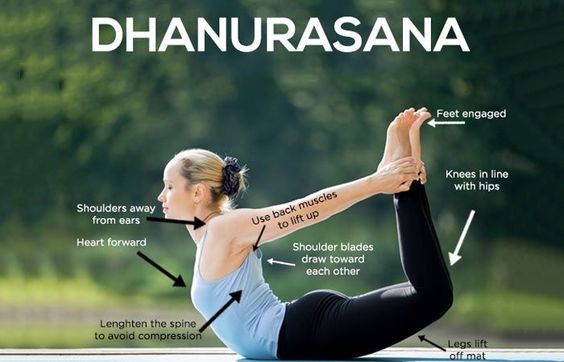
Dhanurasana Steps:
- Lie flat on your abdomen, and press your belly button into the floor. Bend your knees and grab the outside edge of first your right ankle, and then your left ankle.
- Once you have held each ankle firmly, keep your toes together. Inhale deeply while lifting your feet and thighs as high up as you can. Bring your weight forward so that you are resting on your belly instead of your pubic bone.
- Hold this pose for five deep breaths.
Take Away:
In the begining, start with a few from the above list of yoga for PCOS that you can incorporate into your routine easily. Then add more to your list giving a good challenge to your system.
The above daily dose of yoga for PCOS helps you strengthen your affected organs, balance your hormones imbalances and get to a good health condition.
FAQs
What is the main cause of PCOS?
The exact cause of PCOS is not known. Most experts think that several factors, including genetics, play a role: High levels of androgens.
Is PCOS curable?
Polycystic ovary syndrome (PCOS) cannot be cured, but the symptoms can be managed. Treatment options can vary because someone with PCOS may experience a range of symptoms, or just one.
Is PCOD and PCOS same?
PCOS is an illness and a smaller number of women suffer from it compared to those suffering from PCOD. PCOS is an endocrine system’s disorder whereas, PCOD is a medical condition that occurs because of hormonal imbalance.
At what age PCOS starts?
It’s common for women to find out they have PCOS when they have trouble getting pregnant, but it often begins soon after the first menstrual period, as young as age 11 or 12. It can also develop in the 20s or 30s.
Is PCOS caused by obesity?
Obesity is likely not a cause of PCOS, and in many parts of the world, most women with PCOS are of normal weight. However, obesity does exacerbate many aspects of the phenotype, especially cardiovascular risk factors.
Is PCOS serious?
Women with PCOS are more likely to develop certain serious health problems. These include type 2 diabetes, high blood pressure, problems with the heart and blood vessels, and uterine cancer.
Can PCOS be cured by yoga?
Although yoga cannot cure PCOS, it may help with some of the symptoms.
Which Yoga is good for PCOS?
Shavasana. The corpse pose, or Shavasana, can help in relaxing the mind and keeping your cortisol levels in check. Since stress is one of the leading causes of PCOS, yoga for PCOS can help you in de-stressing.
Can surya namaskar cure PCOS?
The 12 sun salutation poses help in bringing down the blood sugar levels and decreasing the chances of heart diseases. This is especially effective for anyone suffering from polycystic ovary syndrome (PCOS) which is a common ailment among today’s women.
